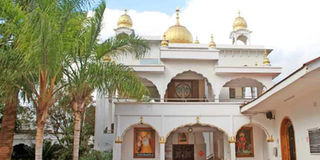Magnificent temple was built in 1926 by Sikh railway workers

One of the three prayer rooms at Makindu Sikh Temple in Makueni County on May 20, 2019. The Sikh temple, which opens its doors to Sikh devotees, travellers and tourists, has been in existence for 93 years. PHOTO | PIUS MAUNDU | NATION MEDIA GROUP
What you need to know:
- The iconic Gurdwara (Sikhs’ place of worship) begun as a small tin hut during the construction of the Kenya-Uganda railway line.
- Sikhs working on the railway line expanded it 1926 and made it their place of worship.
- Makindu was an important service point for the Mombasa-Kisumu section of the railway line project undertaken by colonialists.
Shiny imposing domes against the Makindu township skyline greet travellers on the Mombasa-Nairobi highway. They are installations on three temples that form a Sikh temple complex that has defined the busy trading centre in Makueni County for nearly a century.
HOT MEALS
Tucked in the centre of the complex are rooms sheltered by tall palm trees (Makindu in Kamba language) a large dining hall and kitchen.
The Sikh temple complex is not just open to Sikh pilgrims only; apart from Sikh devotees drawn from all over the world, the iconic building is open to travellers along the Mombasa-Nairobi road, as well as random tourists attracted by the imposing gold-coloured domes on the roofs of this magnificent house of worship. Here, guests are served steaming hot meals and beverages throughout the day and night. Those who want to spend the night are welcome to do so. The temple does not charge for these services, a tradition underpinned in Sikhism.
“Our religion calls for the provision of food to those visiting temples. It does not allow the discrimination of people based on their colour, creed or class,” says Damanjeet Kaur, the facility manager.
Visitors able and willing to donate are welcome to do so; such donations keep the temple running.
The iconic Gurdwara (Sikhs’ place of worship) begun as a small tin hut during the construction of the Kenya-Uganda railway line. Sikhs working on the railway line expanded it 1926 and made it their place of worship. Makindu was an important service point for the Mombasa-Kisumu section of the railway line project undertaken by colonialists determined to open up the East African countryside for trade. Completion of the railway line rendered the Makindu service point useless.
Some of the magnificent buildings at the railway service centre house the present day Makindu Sub-county Hospital, Makindu Police Station and the police staff quarters. The rest stand in ruins at the trading centre.
SACRED SHRINE
The prayer centre for Sikhs who dominated the railway line as artisans and train drivers that developed the Makindu railway service centre withstood the transition and grew into a Sikh temple of its kind in Africa where it is believed that ones prayers are answered.
“When you come to the shrine with a clean heart, your wishes come true and your prayers are answered,” says Kaur, who believes that several women unable to get children conceived shortly after they were prayed for at the shrine. The main temple, a two-storey modern building, is the only building in the county with an elevator.
The Sikh community in Kenya organises regular religious festivals, such as the Akhand Path (recitation of religious texts in Sikhism), which are held at the iconic temple.
These festivals bring together Sikhs from all over the world.
Most of them are relatives of the railway builders and train drivers of yore who later dispersed to various places across the world.
“Makindu gurdwara is a sacred shrine. My guru Gobind Singh resides here. I’m feeling peace of mind while at the shrine,” Giani Lakhwinder Singh Lakha, a Sikh priest and musician visiting from India, told the Nation.
The Sikh temple offers tourists who do not practice the religion an opportunity to soak in the temple’s fabled ambience while enjoying free accommodation and wholesome meals.





